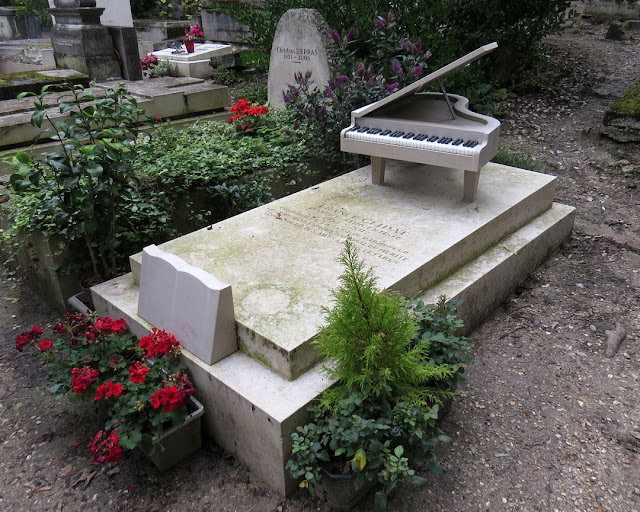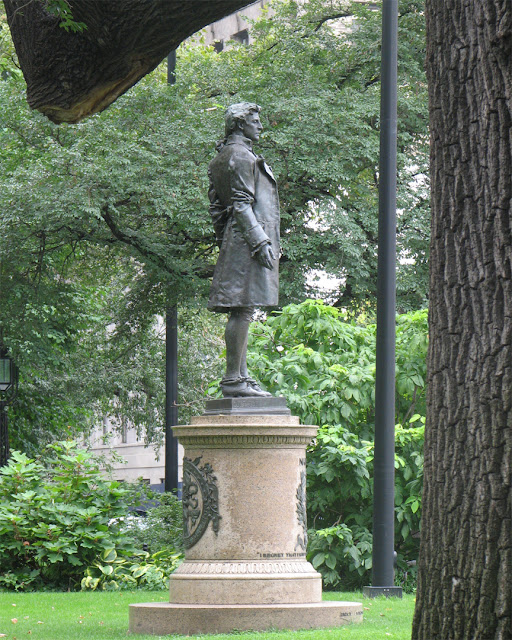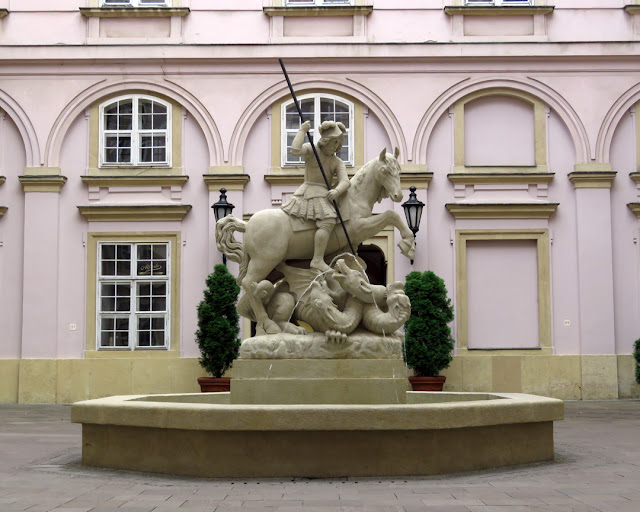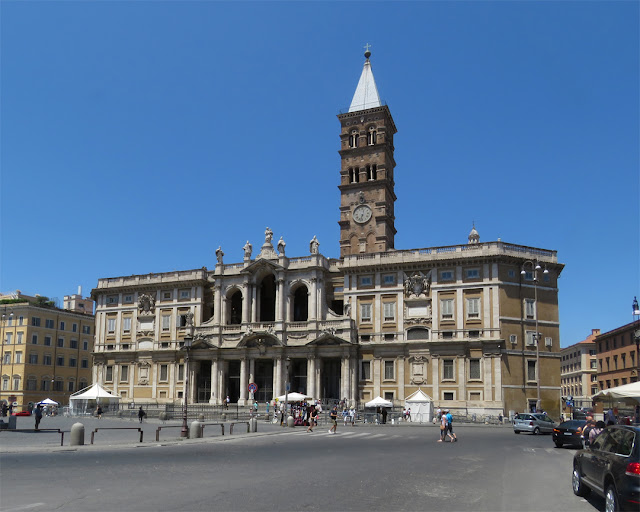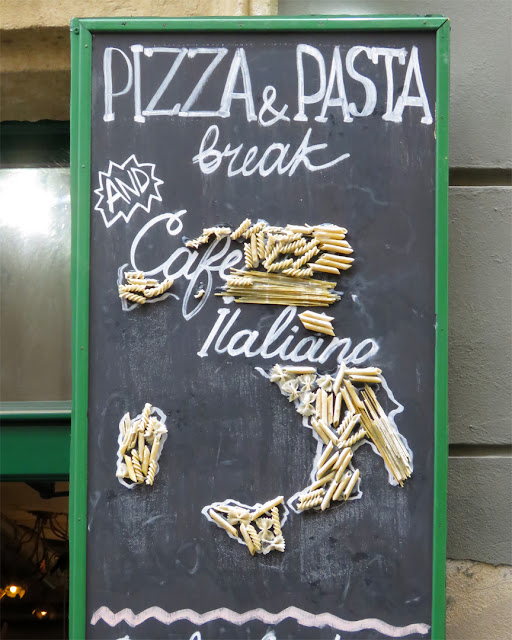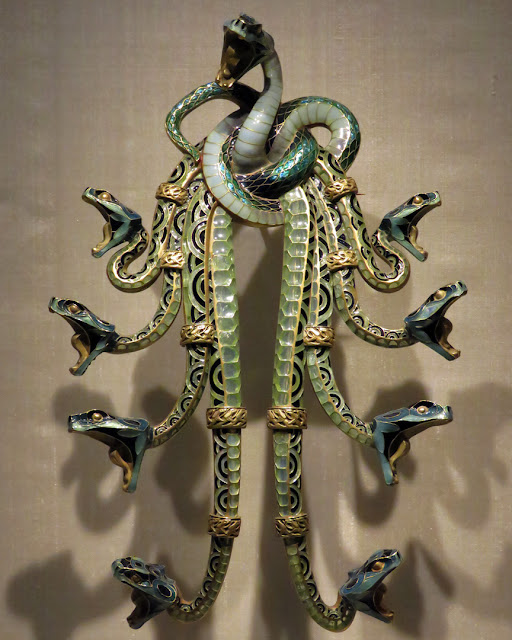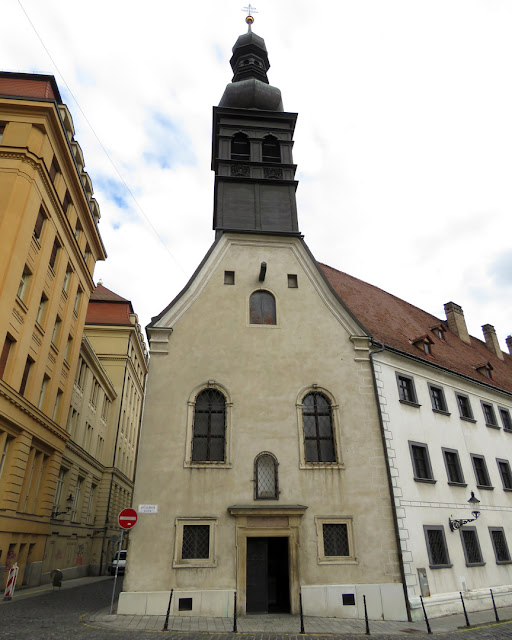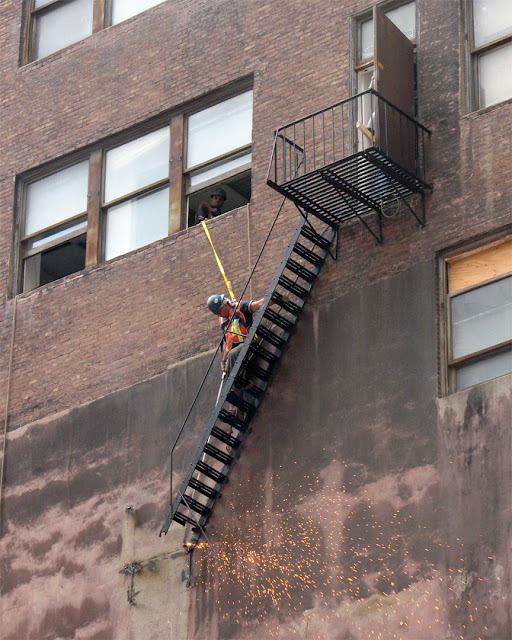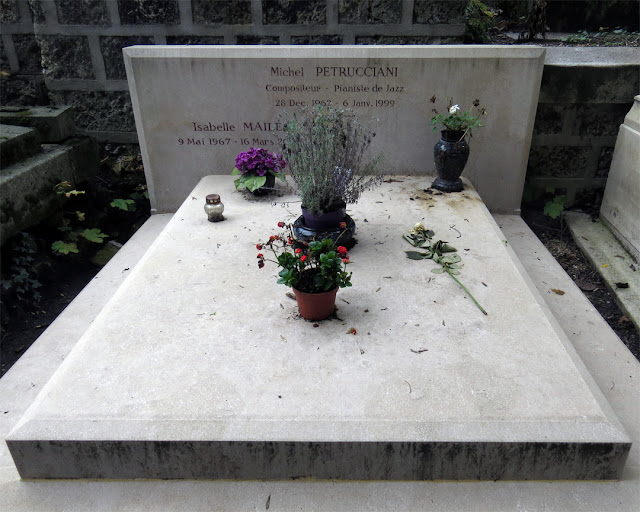Tuesday, December 31, 2019
Monday, December 30, 2019
France Clidat
Grave of France Clidat (1932-2012)
Cimetière du Père-Lachaise, (Père Lachaise Cemetery)
Quartier du Père-Lachaise, 20th arrondissement
Paris, July 2014
“France Clidat (Nantes, 22 November 1932 – Paris, 17 May 2012) was a French pianist renowned for her interpretations of the works of Franz Liszt, a great many of which she recorded, and Erik Satie, whose complete piano works she recorded.” (France Clidat, Wikipedia)
Sunday, December 29, 2019
Via della Pilotta
Via della Pilotta
Rome, September 2019
“However, this ‘secret garden’, concealed behind a high wall, is separated from the Palazzo Colonna by a street, Via della Pilotta. This name refers to a hall-game (as do the words patio and potions) and we know that this quiet street between naked walls - for the palace too turned its back on it - provided excellent opportunities tor games. The chronicler Valesio, mentions in 1740, that the game had become popular here again after an interval of forty years. Prince Colonna and his family naturally had to be able to get from their house to the garden without setting foot on the street and being molested by the sporting activities of young louts. For this reason, two bridges were built over the Via della Pilotta, one at each end of the palace; Don Filippo Colonna was given permission for this by Pope Innocent XII (1691-1700). lt was probably in the 1750's that two more bridges were added between the old ones. As can be seen from plate 92, which shows the one to the south at the entrance to the Via della Pilotta, the original arcades curved in a gentle arch and had a railing borne by balusters, all in straw—yellow travertine. The canting arms of the Colonna Family, a crowned column (colonna), can be seen carved on the plinth above the keystone of the arch.” (Rome: The Biography of Her Architecture from Bernini to Thorvaldsen by Christian Elling)
Saturday, December 28, 2019
Gare do Oriente
Gare do Oriente
Avenida Dom João II
Lisbon, April 2019
“Oriente Station is situated in an urban area of reclaimed industrial and abandoned buildings fronting the northern margin of the Tagus River, situated 6 kilometres (3.7 mi) from the city centre. Ambitious in its conception, the modernist station includes a Lisbon Metro station, a high-speed commuter and regional train hub, a local, national and international bus station, a shopping centre and a police station. The rail station was conceived with a multi-modal platform intersecting the cardinal axes for the various transport modes. With some influence from Gothic architecture, the station bears considerable resemblance to Santiago Calatrava's earlier Allen Lambert Galleria within Toronto's Brookfield Place. Calatrava's objective was to realize a new space with ample room and functionality providing multiple connections between various zones in the metropolitan area of Lisbon.” (Gare do Oriente, Wikipedia)
Friday, December 27, 2019
Dům U České orlice
Dům U České orlice (House at the Czech Eagle), 1897
Ovocný trh
Staré Město (Old Town)
Prague, September 2017
Thursday, December 26, 2019
Giovanni delle Bande Nere
Monument to Giovanni delle Bande Nere by Baccio Bandinelli, 1540
Piazza San Lorenzo
Florence, January 2018
“The Monument to Giovanni delle Bande Nere is a Reinaissance-style marble, outdoor sculptural group located in Piazza San Lorenzo in Florence, region of Tuscany, Italy. The statue was originally commissioned by Cosimo I de Medici in 1540 to commemorate his father, Giovanni delle Bande Nere, the successful condottiero from the Medici family. The sculptor was Baccio Bandinelli. The statue however was controversial from the start: it was debated whether a depiction of an armed soldier should serve as a monument in a church, however even if it was not displayed in a church, it was debated if it was appropriate for a warrior like Giovanni, who had marched against foes most of his life, to be immortalized while sitting down.” (Monument to Giovanni delle Bande Nere, Florence, Wikipedia)
Wednesday, December 25, 2019
Nathan Hale
Nathan Hale by Frederick William MacMonnies, 1890
City Hall Park
Civic Center, Lower Manhattan
New York, September 2007
“This graceful, 13-foot standing bronze figure, sculpted by Frederick MacMonnies (1863-1937), directly faces City Hall and honors the last moments of the 21-year-old American Revolution era spy, Nathan Hale (1755-1776). Disguised as a Dutch schoolteacher, Hale attempted to infiltrate New York’s British ranks to gather intelligence on the enemy’s Long Island military installations. The young man was captured, however, on the night of September 21, 1776 and hanged for treason the next morning on a gallows believed to have been erected near 63rd Street and First Avenue. Since no life portraits of the patriot spy exist, Frederick Macmonnies’s work offers a romantic interpretation of Hale. The bronze statue of the shackled and bound Hale is set upon a granite base and illustrates the hero’s last predawn moments. Though only 26 when he won the Nathan Hale Memorial Competition, Macmonnies’s sculpture brought him great renown in New York City and also won him a medal from the prestigious Paris Salon.” (Nathan Hale, NYC Parks)
Tuesday, December 24, 2019
Fontána Sv. Juraja
Fontána Sv. Juraja / Fountain of Saint George
Primate's Palace courtyard
Staré Mesto (Old Town)
Bratislava, September 2017
Monday, December 23, 2019
Santa Maria Maggiore
Basilica di Santa Maria Maggiore
(Basilica of Saint Mary Major)
Piazza di Santa Maria Maggiore
Rome, June 2019
“The Basilica of Saint Mary Major (Basilica di Santa Maria Maggiore), or church of Santa Maria Maggiore, is a Papal major basilica and the largest Catholic Marian church in Rome, Italy. The basilica enshrines the venerated image of Salus Populi Romani, depicting the Blessed Virgin Mary as the help and protectress of the Roman people, which was granted a Canonical coronation by Pope Gregory XVI on 15 August 1838 accompanied by his Papal bull Cælestis Regina. Pursuant to the Lateran Treaty of 1929 between the Holy See and Italy, the Basilica is within Italian territory and not the territory of the Vatican City State. However, the Holy See fully owns the Basilica, and Italy is legally obligated to recognize its full ownership thereof and to concede to it ‘the immunity granted by International Law to the headquarters of the diplomatic agents of foreign States.’” (Santa Maria Maggiore, Wikipedia)
Sunday, December 22, 2019
A Guerra dos Tronos
“A Guerra dos Tronos” (Game of Thrones)
Gare do Oriente
Parque das Nações
Lisbon, April 2019
“The eighth and final season of the fantasy drama television series Game of Thrones, produced by HBO, is scheduled to premiere on April 14, 2019. Filming officially began on October 23, 2017 and concluded in July 2018.Unlike the first six seasons that each had ten episodes and the seventh that had seven episodes, the eighth season only has six episodes. Like the previous season, it largely consists of original content not found in George R. R. Martin's A Song of Ice and Fire series and adapts material Martin revealed to the showrunners about the upcoming novels in the series, The Winds of Winter and A Dream of Spring. The season was adapted for television by David Benioff and D. B. Weiss.” (Game of Thrones, season 8, Wikipedia)
Saturday, December 21, 2019
Friday, December 20, 2019
Santa Maria dei Ricci
Pipe organ by Chichi Rosario & Figli opus 168, 1989
Santa Margherita in Santa Maria de' Ricci
Via del Corso
Florence, January 2018
Thursday, December 19, 2019
Mould fountain
Detail of the Jacob Wrey Mould fountain
City Hall Park
Civic Center, Lower Manhattan
New York, September 2007
“In 1999 a $34.6 million project fully restored the park, adding a central walkway and gardens and replacing pavement with grass and trees. The Mould fountain with its original granite base was returned to the park with a reconstructed centerpiece and lighting fixtures. A circular tablet at the southern end of the park was added to educate visitors about the history of the site. At the park’s rededication, Mayor Rudolph W. Giuliani called the renovation ‘a final gift from the 20th century to New Yorkers of the 21st.’” (City Hall Park, NYC Parks)
Wednesday, December 18, 2019
Tuesday, December 17, 2019
Chiostro
Chiostro (Cloister)
Basilica di San Giovanni in Laterano
(Archbasilica of Saint John Lateran)
Piazza di San Giovanni in Laterano
Rome, June 2019
“Between the archbasilica and the city wall there was in former times a great monastery, in which dwelt the community of monks whose duty it was to provide the services in the archbasilica. The only part of it which still survives is the 13th century cloister, surrounded by graceful, twisted columns of inlaid marble. They are of a style intermediate between the Romanesque proper and the Gothic, and are the work of Vassellectus and the Cosmati.” (Archbasilica of Saint John Lateran, Wikipedia)
Monday, December 16, 2019
Sunday, December 15, 2019
Miguel Ángel Asturias
Grave of Miguel Ángel Asturias (1899-1974)
Cimetière du Père-Lachaise, (Père Lachaise Cemetery)
Quartier du Père-Lachaise, 20th arrondissement
Paris, July 2014
“Miguel Ángel Asturias Rosales (October 19, 1899 – June 9, 1974) was a Nobel Prize-winning Guatemalan poet-diplomat, novelist, playwright and journalist. Asturias helped establish Latin American literature's contribution to mainstream Western culture, and at the same time drew attention to the importance of indigenous cultures, especially those of his native Guatemala.” (Miguel Ángel Asturias, Wikipedia)
Saturday, December 14, 2019
Friday, December 13, 2019
Potter Building
Potter Building, 1886
Park Row / Beekman Street
Financial District, Lower Manhattan
New York, September 2007
“The Potter Building is a building in the Financial District of Manhattan in New York City. The building occupies a full block along Beekman Street with the addresses 38 Park Row to its west and 145 Nassau Street to its east. It was designed by Norris G. Starkweather in a combination of the Queen Anne and neo-Grec styles, as an iron-framed structure. The Potter Building employed the most advanced fireproofing methods that were available when the building was erected between 1883 and 1886. These features included rolled iron beams, cast iron columns, brick exterior walls, tile arches, and terracotta. The Potter Building was also one of the first iron-framed buildings, and among the first to have a ‘C’-shaped floor plan, with an exterior light courtyard facing Beekman Street. The original design remains largely intact. The building replaced a former headquarters of the New York World, which was built in 1857 and burned down in February 1882. It was named for its developer, the politician and real estate developer Orlando B. Potter. The Potter Building originally served as an office building with many tenants from the media and from legal professions. It was converted into apartments from 1979 to 1981. The Potter Building was designated a New York City landmark in 1996 and is also a contributing property to the Fulton–Nassau Historic District, a National Register of Historic Places district created in 2005.” (Potter Building, Wikipedia)
Thursday, December 12, 2019
Wednesday, December 11, 2019
Madonna di Loreto
Madonna of Loreto or Pilgrim's Madonna by Caravaggio, 1606
Basilica di Sant'Agostino
Rome, June 2019
“The Madonna of Loretto or Pilgrim's Madonna is a famous painting (1604–1606) by the Italian Baroque master Caravaggio, located in the Cavalletti Chapel of the church of Sant'Agostino, near the Piazza Navona in Rome. It depicts the apparition of the barefoot Virgin and naked child to two peasants on a pilgrimage; or as some say it is the quickening of the iconic statue of the Virgin. In 1603 the heirs of marquis Ermete Cavalletti, who had died on 21 July 1602, commissioned for the decoration of a family chapel a painting on the theme of the Madonna of Loreto. Putting into practice the marquis's will, the Cavaletti's on 4 September 1603 purchased a chapel in the church of Sant'Agostino in Rome.” (Madonna di Loreto, Wikipedia)
Tuesday, December 10, 2019
Serpents pectoral
Serpents pectoral (gold and enamel) by René Lalique, 1899
Calouste Gulbenkian Museum
Gulbenkian Park, Avenida de Berna
Lisbon, April 2019
“This pectoral is one of the paradigms of René Lalique’s jewellery production, not only for the mastery of its execution, as for the theme chosen. Reptiles were a source of inspiration to which Lalique returned throughout his life not only for jewellery, but also for his glass, bronzes, etc. The pectoral is made up of nine serpents entwined to form a knot from which the bodies of the other eight fall in a cascade, the ninth rising in the centre, at the top of the jewel. The reptiles, in the attack position, have their mouths open from which strings of pearls were hung as was apparently the case with a similar pectoral (the whereabouts of which are unknown), which was highlighted at the Paris Universal Exhibition in 1900 and reproduced in a publication of the period. The present piece is thus probably the only one in existence. Calouste Gulbenkian acquired it directly from the artist in 1908.” (Serpents pectoral, Calouste Gulbenkian Museum)
Monday, December 9, 2019
Kostol Loretánskej Panny Márie
Kostol Loretánskej Panny Márie (Uršulínsky kostol)
Ursulinska
Staré Mesto (Old Town)
Bratislava, September 2017
Sunday, December 8, 2019
Fishes
One of the medallions depicting fishing activities and the sea
Loggia del Pesce
Piazza dei Ciompi
Florence, January 2018
Saturday, December 7, 2019
Oxy-fuel cutting
Oxy-fuel cutting
Broadway / Canyon of Heroes
Financial District, Lower Manhattan
New York, September 2007
Friday, December 6, 2019
Thursday, December 5, 2019
MACRO Asilo
MACRO as MACRO Asilo
Museum of Contemporary Art
Via Nizza 138
Rome, June 2019
“1 Oct 2018-31 Dec 2019. MACRO on Via Nizza will be free to visitors for 15 months as part of an experimental art project, known as Asilo (meaning refuge), under the direction of curator Giorgio de Finis. Asilo opens with a party at 16.00 on 30 September and the first month of the project includes major names such as Michelangelo Pistoletto, Pablo Echaurren and Pietro Ruffo. MACRO Asilo will see the participation of 250 contemporary artists who will be given space to work, perform and interact with the public. The programme envisages the creation of 400 videoart works, 1,000 lessons, 60 Saturday night concerts and 900 self-portraits. De Finis, known to many as the founder of Rome's MAAM street art museum, says the traditional exhibition format will be abandoned with the goal of transforming MACRO into a ‘living museum.’ The series of 180 lectures will also feature international artists such as Claire Bishop, Mary Ann Caws, Don Thompson, Calum Storrie, Sally Price and Paul Werner.” (Rome's MACRO Asilo opens its doors for free, Wanted in Rome)
Wednesday, December 4, 2019
Tuesday, December 3, 2019
Monday, December 2, 2019
Nativity scene
Nativity scene
Chiostro dei Morti (Cloister of the Dead)
Basilica di Santo Spirito (Basilica of the Holy Spirit)
Florence, January 2018
Sunday, December 1, 2019
Michel Petrucciani
Grave of Michel Petrucciani (1962-1999)
Cimetière du Père-Lachaise, (Père Lachaise Cemetery)
Quartier du Père-Lachaise, 20th arrondissement
Paris, July 2014
“Michel Petrucciani (28 December 1962 – 6 January 1999) was a French jazz pianist. From birth he had osteogenesis imperfecta, a genetic disease that causes brittle bones and, in his case, short stature. He became one of the most accomplished jazz pianists of his generation despite having pain in his arms.” (Michel Petrucciani, Wikipedia)
Subscribe to:
Posts (Atom)


